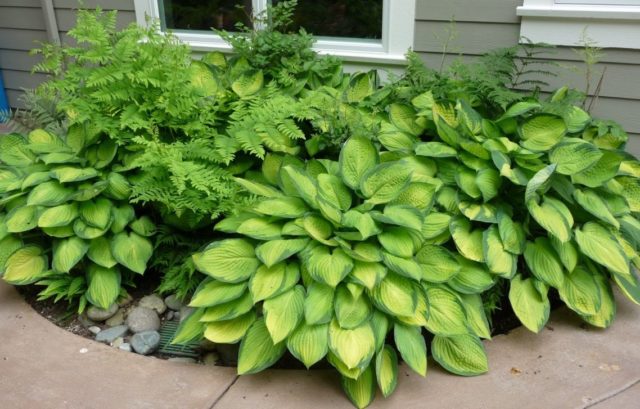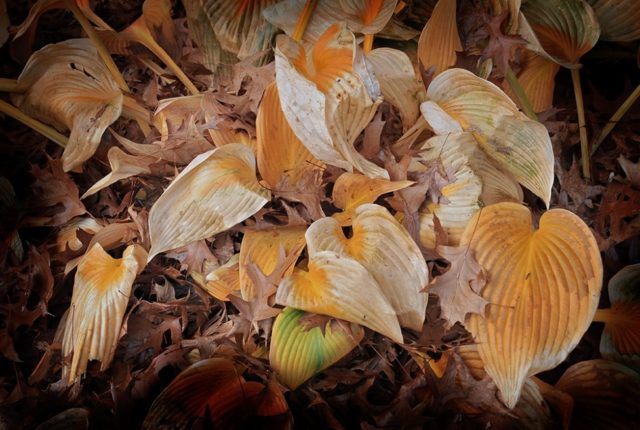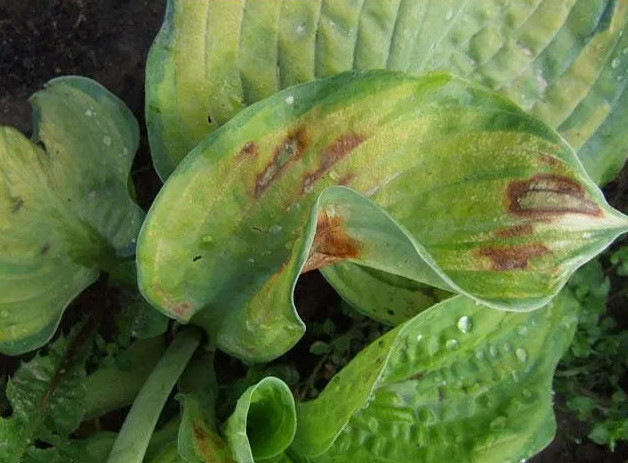Content
Hosta Gold Standard is a popular hybrid variety that gets its name from the unique color of its leaves. Due to its decorative properties, such a shrub is used for landscaping areas. The plant is characterized by unpretentious care, therefore it can be grown by both experienced and novice growers.
Description of hosts Gold Standard
It is a perennial shrub plant. It has a domed shape. The height of the bushes reaches 70 cm.The diameter of adult specimens is up to 120 cm.
Each bush contains numerous short stems with many leaves. Hosta variety "Gold Standard" is spreading, but due to the large number of shoots, it does not deform. The stems are dense, so they can support the weight of the leaves and do not need a garter or additional support.
Leaves of the hosta "Gold Standard" are basal. They are heart-shaped with pointed tips. In length they reach 12-14 cm.
The color of the hosta leaves depends on the season. In the spring, they are light green. In the future, the leaves become yellow-golden. With abundant sunlight during the summer season, they can fade. Then the leaves of the hosta become creamy white with a dark green border on the sides.

Hosta grows beautifully in the shade
The flowering period is in the middle of summer. In mid-latitudes, it begins at the end of June and ends after 3-4 weeks. During this period, small flowers (4-6 cm each) of lavender color are formed on the shoots. They gather in clusters growing on non-leafy stems. More about flowering:
The plant can be grown in areas with any degree of light. Shaded areas work best. In well-lit areas, cultivation is allowed, provided that the host is in the shade at midday. This is due to the fact that excess solar ultraviolet light can provoke leaf burnout. At the same time, the host should not be planted in full shade, as otherwise it will remain dark green.
The Gold Standard variety is frost-resistant. The host can be grown in almost any climatic zone. This requires elementary periodic care.
Application in landscape design
The host "Gold Standard" was bred by the selection method for decorative use. Due to the abundant foliage, these shrubs go well with numerous plants. Hosts are often planted under trees to visually fill the site. A single planting of bushes in flower beds, near curbs, and various landscape elements is also allowed.
Gold Standard hosts go well with the following colors:
- lungwort;
- peonies;
- geycher;
- phlox;
- lilies;
- gladioli;
- lavender;
- astilba.

Often, Gold Standard bushes are planted around trees, near water bodies and on alpine slides
When combining bushes on a site, one should take into account not only their color features. An important condition is the requirements for the composition of the soil. Gold Standard grows well in all treated soils, while other plants may be sensitive to soil imperfections.
Breeding methods
The method of dividing the bush is recognized as the most effective. The procedure is carried out in mid-spring and early summer.For division, an adult hosta (from 4 years old) with a large number of shoots and leaves is chosen. At the beginning of the growing season, forming buds are removed from the bush.
Division Algorithm:
- The bush is dug on one side to get to the roots.
- Several shoots with roots are separated with a sharp blade or knife.
- The place of the cut on the main bush is treated with sand.
- The separated shoots are planted in a pot or greenhouse.
- After 3-4 weeks, they are transferred to open ground.

Hosta reproduces by bush division, cuttings and seeds
Reproduction of Fortune Gold Standard hosts by seeds is allowed. After flowering, a triangular leathery capsule is formed on the shrubs. Numerous seeds are formed in it, which remain viable for 1 year. They are dried, then planted in small pots, pretreated with disinfectants. Topsoil - no more than 1 cm.
Seedlings are kept at a temperature of 18-25 degrees. Sun exposure is excluded. Periodically, the pot is placed in a lighted place for no longer than 2 hours. Seedlings are transferred to open ground in early autumn, when the temperature does not drop below 20 degrees.
Landing algorithm
Hosts of the "Gold Standard" variety grow well in areas with any type of soil. The most important criterion when choosing a site is soil moisture. The higher it is, the more leaves grow on the bushes. This is especially important in the summer, when the heat quickly evaporates the moisture.
Hosta negatively affects the stagnation of fluid with abundant watering. Therefore, the soil must be well drained. Young specimens require increased nutritional value so that the root system grows faster and the bush adapts to external conditions.
After choosing a place, boarding takes place in the following way:
- Dig a round hole 40-50 cm deep.
- Drainage is placed at the bottom in combination with a dry garden substrate.
- A layer of cleaned soil mixed with peat and compost is poured on top.
- The seedling is placed in such a way that the buds are placed at a depth of 1-2 cm.
- Sprinkle on top with loose soil, watered.

The landing site must be well protected from the wind
Planting is recommended in the fall. Then the plant takes root better and quickly adapts to unfavorable factors. If you plant the Gold Standard bush in the spring, the nutrients from the soil will be spent on the formation of peduncles, and not the root system. This, in turn, will negatively affect the adaptive abilities of the plant.
Growing rules
The plant is very popular largely due to its unpretentiousness. Care provides for a minimum set of measures.
At all stages of the growing season, it is required to remove weeds growing near the bushes. Another mandatory requirement is regular watering. In the summer, you need to supply the plant with liquid at least 2 times a week. At least 10 liters of separated water is recommended for each Gold Standard host.
The plant responds well to feeding. For such, hosts use both organic and mineral fertilizers.
The main task of top dressing is to increase the nutritional value of the soil. For these purposes, it is best to use organic fertilizer.
Among them:
- compost;
- manure or droppings mixed with straw;
- humus;
- peat;
- hay;
- pine needles.
Mineral slurries can also be used for the Gold Standard grade. However, foliar granular dressings are considered the best option. Fertilizers are used, consisting of phosphorus, nitrogen and potassium.

Fertilizers need to be applied no more than 3 times per season.
Organic matter is applied in spring, when the plant wakes up after winter. Mineral makeup is carried out after 2 weeks.In summer, it is recommended to make solutions with phosphorus and potassium before flowering.
In the spring, it is necessary to loosen the soil. This is especially important when there is heavy rainfall, due to which the soil is compacted. It is recommended to mulch once a month using peat, sawdust, hay or straw to slow down the evaporation of liquid from the soil.
Preparing for winter
The buds should be removed immediately after flowering, unless seed collection is planned. In the middle of autumn, the leaves of the Gold Standard hosta begin to fade.

"Gold Standard" is a winter-hardy and frost-hardy variety
During this period, they can be removed along with the stems. The remaining aerial shoots must be covered with loose soil. After that, fertilize the soil around with a mineral solution, and also treat it with a fungicide. It is best to mulch the ground with fallen leaves and compost.
In regions where winter passes without severe frosts, it is not necessary to cover the host. If the temperature drops below -20 degrees, the plant should be protected with spruce branches, branches or brushwood.
Diseases and pests
One of the features of the Gold Standard variety is its exceptional resistance to infections. The plant is not characterized by fungal and bacterial lesions. An exception is gray mold, which can develop due to excess moisture. To combat pathology, it is recommended to use fungicides, as well as to remove the affected areas in order to exclude infection of neighboring plants.

Most often, the host is attacked by slugs, they feed on its leaves and as a result, it loses its decorative appeal.
The most common host pests are slugs and snails. However, the Gold Standard variety is resistant to them. As a preventive measure, the soil around the bush can be sprinkled with tobacco ash, which repels pests.
Conclusion
Hosta Gold Standard is a unique plant with unsurpassed adaptive abilities. The bush can be planted on any soil with different light levels. Plant care is reduced to a minimum set of activities. Moreover, such hosts are distinguished by excellent decorative properties, which is why they are often used for landscaping.








